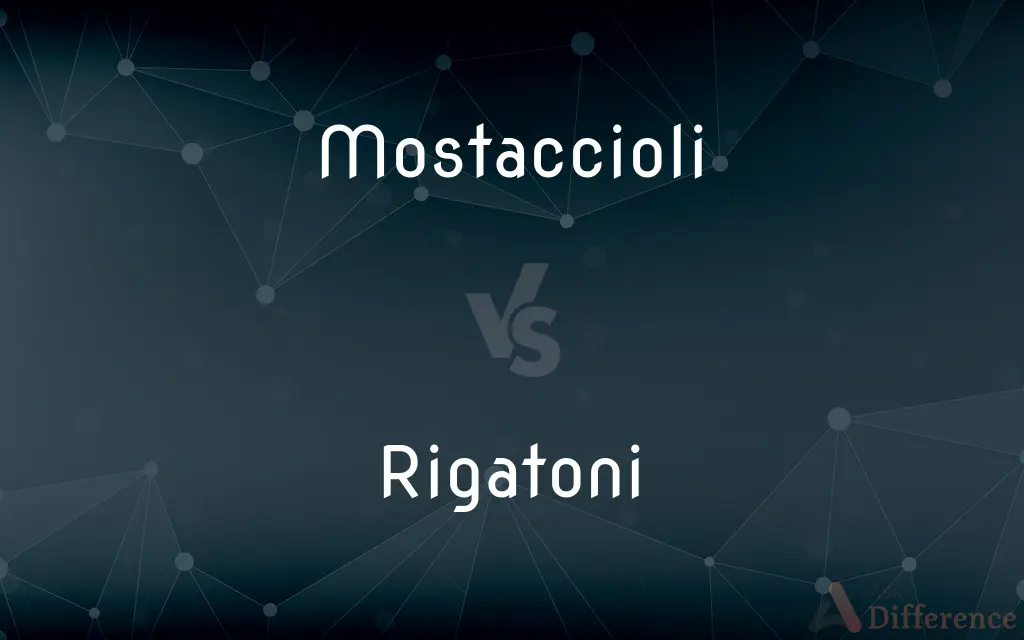Mostaccioli vs. Rigatoni — What's the Difference?
By Maham Liaqat & Fiza Rafique — Updated on April 5, 2024
Mostaccioli are smooth or ridged tube-shaped pasta, resembling penne but larger, while rigatoni are larger, ridged tubes with square-cut ends, offering a more textured surface.

Difference Between Mostaccioli and Rigatoni
Table of Contents
ADVERTISEMENT
Key Differences
Mostaccioli, often likened to a larger version of penne, is a type of pasta known for its tube shape that can be either smooth (lisce) or ridged (rigate). This pasta is particularly popular in American-Italian cuisine, serving as a base in baked pasta dishes where its smooth or slightly textured surface allows sauces and cheeses to adhere well, creating a harmonious blend of flavors. On the other hand, rigatoni stands out with its distinctive ridges and square-cut ends, features that make it especially adept at trapping and holding onto sauces. The ridges provide a more textured experience, which ensures that every bite is enriched with the sauce, making rigatoni ideal for thick and chunky sauces.
Mostaccioli’s smooth surface and subtle texture variations (in the ridged version) make it versatile for both light and moderately thick sauces. Its design is conducive to absorbing flavors while maintaining a firm structure, making it a favorite for dishes that require baking. In contrast, rigatoni’s pronounced ridges and wider openings at the ends make it particularly suitable for hearty sauces with meat or vegetables, as these can nestle within the pasta, ensuring a flavorful experience with each mouthful.
The choice between mostaccioli and rigatoni often comes down to the desired interaction between pasta and sauce. Mostaccioli, with its slightly smoother texture, is well-suited for dishes where a delicate balance between pasta and sauce is desired, allowing for a uniform flavor distribution. Rigatoni, with its more aggressive texture, is preferred in dishes that demand a robust sauce engagement, making it perfect for capturing every element of the sauce.
Both mostaccioli and rigatoni share the commonality of being excellent carriers for a variety of sauces due to their hollow shapes. However, the presence or absence of ridges and the shape of the ends significantly influence their culinary uses. While mostaccioli might be chosen for its ability to provide a consistent texture and flavor in every bite, rigatoni is selected for its capacity to offer a more dynamic eating experience, with the ridges enhancing the sauce's texture and flavor adherence.
In essence, the main difference lies in their surface texture and the way they interact with sauces. Mostaccioli is preferred for its versatility and ability to complement a wide range of dishes, offering a more uniform texture and sauce distribution. Rigatoni, however, is the go-to option for those looking to maximize sauce retention and enjoy a richer texture, making each pasta uniquely suited to different culinary preparations.
ADVERTISEMENT
Comparison Chart
Shape
Tube-shaped, similar to penne but larger
Large, ridged tubes with square-cut ends
Texture
Smooth or slightly ridged
Pronounced ridges
Sauce Affinity
Good for light to moderately thick sauces
Ideal for thick, chunky sauces
Cut Ends
Diagonal or straight, depending on the variety
Characteristically square-cut
Culinary Use
Versatile, often used in baked dishes
Preferred for dishes with robust, hearty sauces
Compare with Definitions
Mostaccioli
Can be smooth or ridged.
Mostaccioli rigate holds onto creamy sauces well.
Rigatoni
Great for meaty sauces.
Rigatoni easily traps pieces of meat in its hollow center.
Mostaccioli
Tube-shaped pasta, often used in baked dishes.
Baked mostaccioli with marinara and mozzarella.
Rigatoni
Offers dynamic eating experience.
Rigatoni with pesto and pine nuts provides a mix of textures and flavors.
Mostaccioli
Versatile in use.
Mostaccioli serves as a base for both light and rich pasta dishes.
Rigatoni
Ideal for thick sauces.
The ridges of rigatoni make it perfect for chunky vegetable sauces.
Mostaccioli
Ideal for absorbing flavors.
Mostaccioli in a vodka sauce becomes infused with flavor.
Rigatoni
Enhances texture interaction.
Rigatoni's ridges add a pleasing texture to each bite.
Mostaccioli
Larger than penne.
Mostaccioli provides a heartier texture in pasta salads.
Rigatoni
Large, ridged tube pasta with square-cut ends.
Rigatoni with Bolognese sauce is a classic pairing.
Mostaccioli
Pasta in short tubes with slanted ends.
Rigatoni
Rigatoni (Italian: [riɡaˈtoːni]) are a form of tube-shaped pasta of varying lengths and diameters originating in Italy. They are larger than penne and ziti, and sometimes slightly curved, though not as curved as elbow macaroni.
Mostaccioli
A type of penne pasta which resembles ziti.
Rigatoni
Pasta in the form of short hollow fluted tubes.
Mostaccioli
Pasta somewhat resembling little moustaches
Rigatoni
Pasta in ribbed, slightly curved, large-sized tubes.
Rigatoni
A ribbed tubular form of pasta, larger than penne but with square-cut ends, often slightly curved.
Rigatoni
Tubular pasta in short ribbed pieces
Common Curiosities
What is the primary difference between mostaccioli and rigatoni?
The primary difference is in their texture: mostaccioli can be smooth or slightly ridged, while rigatoni has pronounced ridges and square-cut ends.
Are there dishes that specifically call for either mostaccioli or rigatoni?
Yes, certain recipes specify using one or the other based on how the pasta's texture interacts with the other ingredients, particularly the sauce.
Why choose mostaccioli for a dish?
Mostaccioli is chosen for its versatility and ability to provide a consistent texture and flavor, especially in baked dishes.
Can mostaccioli and rigatoni be used interchangeably in recipes?
While they can sometimes be substituted for each other, their different textures mean they interact with sauces in distinct ways, affecting the final dish's outcome.
What makes rigatoni suitable for thick sauces?
Rigatoni's pronounced ridges and wider tube shape make it ideal for capturing and holding thick, chunky sauces, enhancing flavor with each bite.
Is one type of pasta better than the other?
Neither is inherently better; the choice depends on personal preference and the specific requirements of the dish being prepared.
How does the shape of pasta affect its culinary use?
The shape influences how pasta holds onto sauces, the texture of each bite, and the overall balance of flavors and ingredients in a dish.
What sauces pair well with mostaccioli?
Mostaccioli pairs well with a range of sauces, from light tomato to cream-based sauces, due to its versatile shape and texture.
Why might a chef choose rigatoni for a hearty dish?
A chef might choose rigatoni for its ability to interact robustly with hearty, meaty, or chunky sauces, providing more unique flavour.
What is the primary use of mastacciloi?
Mostaccioli serves as a base for both light and rich pasta dishes.
Share Your Discovery

Previous Comparison
Orderly vs. Communicative
Next Comparison
Overproof vs. UnderproofAuthor Spotlight
Written by
Maham LiaqatCo-written by
Fiza RafiqueFiza Rafique is a skilled content writer at AskDifference.com, where she meticulously refines and enhances written pieces. Drawing from her vast editorial expertise, Fiza ensures clarity, accuracy, and precision in every article. Passionate about language, she continually seeks to elevate the quality of content for readers worldwide.
















































